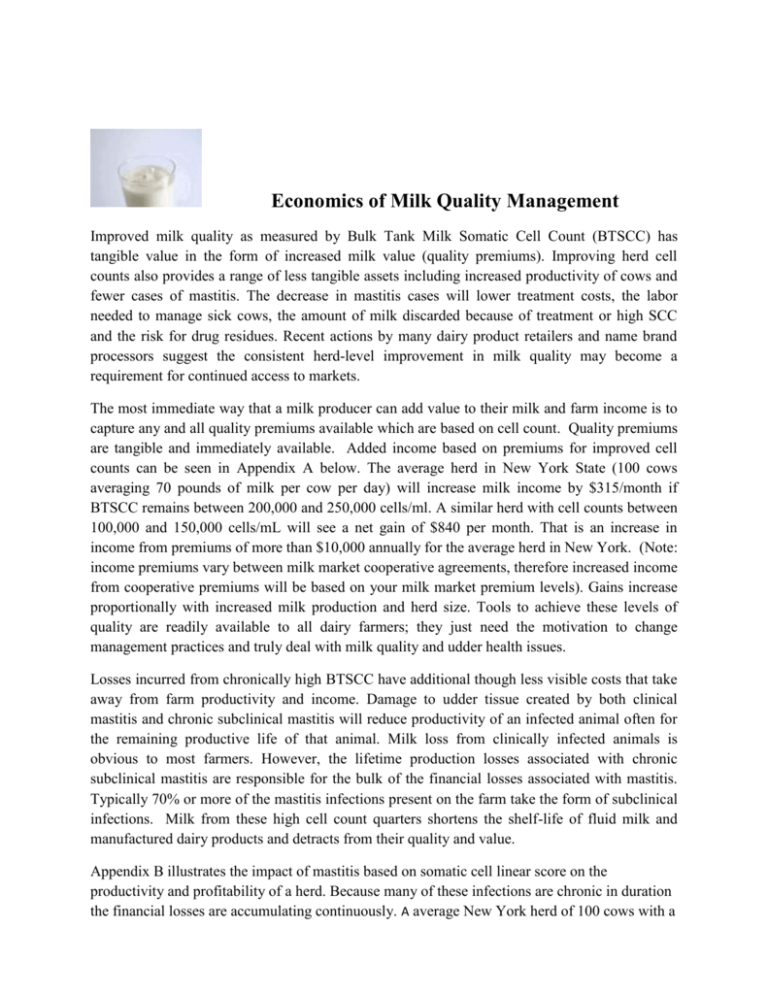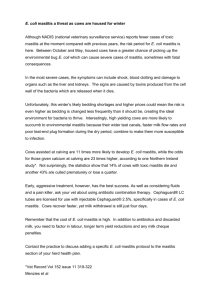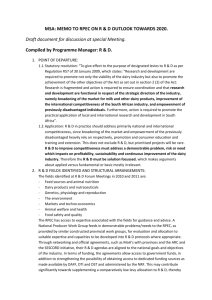Economics of Milk Quality Management with Examples 1-5-11
advertisement

Economics of Milk Quality Management Improved milk quality as measured by Bulk Tank Milk Somatic Cell Count (BTSCC) has tangible value in the form of increased milk value (quality premiums). Improving herd cell counts also provides a range of less tangible assets including increased productivity of cows and fewer cases of mastitis. The decrease in mastitis cases will lower treatment costs, the labor needed to manage sick cows, the amount of milk discarded because of treatment or high SCC and the risk for drug residues. Recent actions by many dairy product retailers and name brand processors suggest the consistent herd-level improvement in milk quality may become a requirement for continued access to markets. The most immediate way that a milk producer can add value to their milk and farm income is to capture any and all quality premiums available which are based on cell count. Quality premiums are tangible and immediately available. Added income based on premiums for improved cell counts can be seen in Appendix A below. The average herd in New York State (100 cows averaging 70 pounds of milk per cow per day) will increase milk income by $315/month if BTSCC remains between 200,000 and 250,000 cells/ml. A similar herd with cell counts between 100,000 and 150,000 cells/mL will see a net gain of $840 per month. That is an increase in income from premiums of more than $10,000 annually for the average herd in New York. (Note: income premiums vary between milk market cooperative agreements, therefore increased income from cooperative premiums will be based on your milk market premium levels). Gains increase proportionally with increased milk production and herd size. Tools to achieve these levels of quality are readily available to all dairy farmers; they just need the motivation to change management practices and truly deal with milk quality and udder health issues. Losses incurred from chronically high BTSCC have additional though less visible costs that take away from farm productivity and income. Damage to udder tissue created by both clinical mastitis and chronic subclinical mastitis will reduce productivity of an infected animal often for the remaining productive life of that animal. Milk loss from clinically infected animals is obvious to most farmers. However, the lifetime production losses associated with chronic subclinical mastitis are responsible for the bulk of the financial losses associated with mastitis. Typically 70% or more of the mastitis infections present on the farm take the form of subclinical infections. Milk from these high cell count quarters shortens the shelf-life of fluid milk and manufactured dairy products and detracts from their quality and value. Appendix B illustrates the impact of mastitis based on somatic cell linear score on the productivity and profitability of a herd. Because many of these infections are chronic in duration the financial losses are accumulating continuously. A average New York herd of 100 cows with a BTSCC average of 200,000 cells/ml (Linear Score = 4) incurs lost income of $1530/month with a milk price of $17.00/cwt. This same herd with a BTSCC average of 400,000 cells/ml (Linear Score = 5) has lost and additional $765/month pushing total losses to $2295/month. As milk prices and BTSCC increase economic losses continue to grow. There is a simple spreadsheet created by Dr. John Fetrow, University of Minnesota, which allows dairy farmers to calculate the cost and income loss associated with mastitis. The losses include those associated with the treatment, culling and deaths associated with clinical mastitis as well as the calculated value of milk losses associated with elevated BTSCC. This spread sheet can be accessed at: http://www.ansci.umn.edu/dairy/QUALITY%20COUNTS/Quality%20Counts.html This is an EXCEL spreadsheet and is simple to use. Herd data taken from stated herd goals and performance records (DHIA data) are entered into the yellow shaded cells. The first entry box provides four simple herd goals including BTSCC goal, % of clinical cases per month, number of cow deaths annually from mastitis and the number of culls due to mastitis/high SCC for the year. The next data box includes the description of the herd and current mastitis information. Included are herd inventory, current milk price, culling data, average annual BTSCC, replacement costs, etc. The third and last input box is concerned with costs associated with clinical mastitis including the number of clinical cases per month cost and duration of treatment and milking withhold. A summary of losses is provided at the top of the spreadsheet. They include losses associated with clinical cases of mastitis, the value of production losses associated with subclinical mastitis, losses due to excessive culling due to mastitis and often the most costly the loss of income from quality premiums. These data will also appear as a pie chart to the right of the summary. At the bottom of the chart is a summary of the milk loss associated with high BTSCC (subclinical mastitis) and another characterizing the monetary losses due to culling and death of affected animals. It is clear that cows with subclinical mastitis produce less milk, often 10% to 20% less milk over a lactation. The greatest economic losses attributed to high BTSCC are due to loss of quality premiums. The monetary loss due to mastitis in general is due to lower milk production. Additional losses are linked to a higher replacement costs; treatment, labor, drug and veterinary costs associated with clinical mastitis. The costs associated with improving udder health and milk quality are small compared to the returns that a farmer is likely to receive. The costs of implementing mastitis control procedures and changing management’s perspective concerning mastitis control are often returned to the farm in a matter of weeks to months. Farmers will also benefit from the peace of mind in knowing that producing higher quality milk leads to assurances of continued access to their milk markets. 2 Appendix A: Quick reference for various milk quality payments. Total Value per Month, per 100 Cows, Quality Premium added or subtracted (to gross milk price) Pounds of milk per cow per day SCC <101,000 101-150 151-200 201-250 251-300 301-600 601-750 >751 Per Cwt Premium $0.60 $0.55 $0.50 $0.45 $0.40 $0.35 $0.30 $0.25 $0.20 $0.15 $0.10 $0.05 $0.00 -$0.05 -$0.10 -$0.15 -$0.20 -$0.25 -$0.30 -$0.35 -$0.40 55 $990 $908 $825 $743 $660 $578 $495 $413 $330 $248 $165 $83 $0 -$83 -$165 -$248 -$330 -$413 -$495 -$578 -$660 60 $1,080 $990 $900 $810 $720 $630 $540 $450 $360 $270 $180 $90 $0 -$90 -$180 -$270 -$360 -$450 -$540 -$630 -$720 65 $1,170 $1,073 $975 $878 $780 $683 $585 $488 $390 $293 $195 $98 $0 -$98 -$195 -$293 -$390 -$488 -$585 -$683 -$780 3 70 $1,260 $1,155 $1,050 $945 $840 $735 $630 $525 $420 $315 $210 $105 $0 -$105 -$210 -$315 -$420 -$525 -$630 -$735 -$840 75 $1,350 $1,238 $1,125 $1,013 $900 $788 $675 $563 $450 $338 $225 $113 $0 -$113 -$225 -$338 -$450 -$563 -$675 -$788 -$900 80 $1,440 $1,320 $1,200 $1,080 $960 $840 $720 $600 $480 $360 $240 $120 $0 -$120 -$240 -$360 -$480 -$600 -$720 -$840 -$960 85 $1,530 $1,403 $1,275 $1,148 $1,020 $893 $765 $638 $510 $383 $255 $128 $0 -$128 -$255 -$383 -$510 -$638 -$765 -$893 -$1,020 90 $1,620 $1,485 $1,350 $1,215 $1,080 $945 $810 $675 $540 $405 $270 $135 $0 -$135 -$270 -$405 -$540 -$675 -$810 -$945 -$1,080 Appendix B: 4 Appendix C: 5 6




